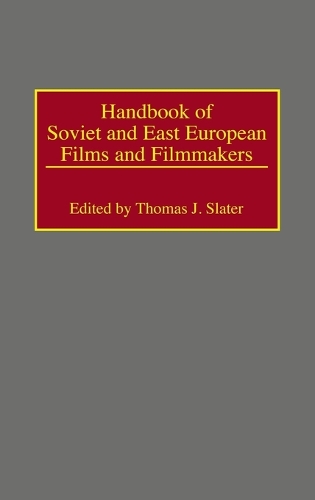
Handbook of Soviet and East European Films and Filmmakers
(Hardback)
Publishing Details
Handbook of Soviet and East European Films and Filmmakers
By (Author) Thomas J. Slater
Bloomsbury Publishing PLC
Greenwood Press
30th November 1991
United States
Classifications
Tertiary Education
Non Fiction
791.430947
Physical Properties
Hardback
464
Description
In Eastern Europe artists, intellectuals and entertainers are now free to create film outside the direct control of the State. This handbook aims to show how much film art was still being produced behind the Iron Curtain even during such repressive periods as those under Stalin and Brezhnev. By means of detailed historiographical essays for each country, the author has compiled a history of cinematic evolution in the Soviet Union and Eastern Europe. The dramatic changes in political and economic structures that occurred during 1989 and 1990 have revealed even more about courageous film-makers who worked under difficult conditions. Many were still able to produce artistically important films, but they were often forced to become propagandizers for their authoritarian governments. The book outlines their film achievements and examines how their people responded to the films they were allowed to see. The appendix consists of a chronology of major historical, cultural and film events of the last 100 years.
Reviews
In surveying the film output of seven East European countries and the (former) Soviet Union to 1990, this handbook is well timed to summarize the full period during which communist governments controlled the cinema of the region. Each of the countries (Soviet Union, Poland, Czechoslovakia, Yugoslavia, Hungary, East Germany, Romania, and Bulgaria) is treated in a separate chapter, containing a general essay, bibliography, brief biographical sketches of key persons (primarily directors), and selected filmography. Emphasis is on feature-length fictional films; shorts, animations, and documentaries are generally excluded. Two indexes are provided: a film index with both foreign and translated versions of film titles, and a subject index covering individuals as well as topics such as "World War II" and "Hungarian Revolution (1956)." An overall chronology of major "historical, cultural and film events" of the region is also included. A useful addition to the literature since earlier books on the topic are not organized as reference works; recommended for strong film collections in upper-division undergraduate and university libraries.-Choice
Still, students and scholars of the genre will find this volume a valuable resource.-ARBA
"Still, students and scholars of the genre will find this volume a valuable resource."-ARBA
"In surveying the film output of seven East European countries and the (former) Soviet Union to 1990, this handbook is well timed to summarize the full period during which communist governments controlled the cinema of the region. Each of the countries (Soviet Union, Poland, Czechoslovakia, Yugoslavia, Hungary, East Germany, Romania, and Bulgaria) is treated in a separate chapter, containing a general essay, bibliography, brief biographical sketches of key persons (primarily directors), and selected filmography. Emphasis is on feature-length fictional films; shorts, animations, and documentaries are generally excluded. Two indexes are provided: a film index with both foreign and translated versions of film titles, and a subject index covering individuals as well as topics such as "World War II" and "Hungarian Revolution (1956)." An overall chronology of major "historical, cultural and film events" of the region is also included. A useful addition to the literature since earlier books on the topic are not organized as reference works; recommended for strong film collections in upper-division undergraduate and university libraries."-Choice
Author Bio
THOMAS J. SLATER is Assistant Professor of Film and Literature at Indiana University of Pennsylvania. He is the author of Milos Forman: A Bio-Bibliography (Greenwood Press, 1987).
